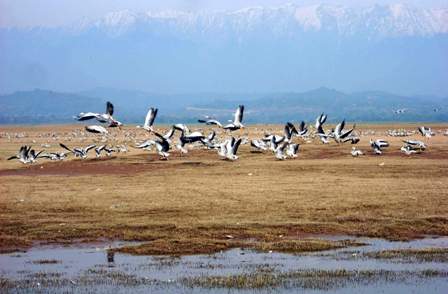
Shimla: Himachal Pradesh is going to hold a unique event – a race to spot and count feathered guests at the Pong dam wetlands in the Kangra Valley over two days from Jan 30.
The annual waterbird census, both local and migratory, will be held at the Pong Dam reservoir in Kangra district.
More than 150 bird watchers and staff of the wildlife department will participate in the dawn-to-dusk exercise, Chief Conservator of Forests Sanjeeva Pandey said .
He said ornithologists of the Bombay Natural History Society (BNHS), the Wildlife Institute of India and the Zoological Survey of India are participating.
Bird watchers of the Delhi Bird Club, Chandigarh Bird Club and Pong Birding Society will also participate.
The Pong Dam reservoir, 250 km from state capital Shimla, is one of the largest man-made wetlands in the foothills of the Himalayas.
With the onset of winter, thousands of migratory birds from central and northern Asia start arriving for their annual sojourn in Pong.
“As per our estimates around 1.25 lakh migratory birds of more than 100 species are roosting and feeding in Pong right now,” Range officer (Pong wetlands) D.S. Dadwal said.
He said that the largest influx was of the bar-headed geese, coot, common pochard, red-crested pochard, great cormorant, gadwall, northern pintail, river tern and the spotbill duck.
Prabhat Bhatti, a professional wildlife photographer based at Nangal in Punjab who participated in the last two censuses at Pong, said the influx of birds could be seen in the Nagrota Suriyan, Sathana, Sansarpur Terrace and Rancer Island areas.
For the first time the wildlife wing this year spotted the Falcated Duck in Pong.
Experts say this silvery plumage species is predominantly found in China and in smaller numbers in Japan, North and South Korea.
The Pong wetlands are also home to many native birds like the red jungle fowl, large Indian parakeet, Indian cuckoo, bank myna, wood shrike, yellow-eyed babbler, black ibis, paradise flycatcher, crested lark and the crested bunting.
The bar-headed goose, the world’s highest-altitude migrant, is a regular winter visitor here.
During the last census by the wildlife department at the Pong reservoir in January 2011, over 132,000 migratory waterbirds of 95 species were recorded. The Pied Avocet – a wading bird species – was spotted for the first time.
Interestingly, four migratory birds – three bar-headed geese and one ruddy shelduck – that were tagged with global positioning system (GPS) transmitters last year returned to Pong this year after travelling thousands of miles.
The wildlife department, in association with Mumbai-based BNHS (Bombay Natural History Society), had tagged the migratory birds for the first time in Pong as part of its work to track and monitor them.
BNHS assistant director S. Balachandran, who installed the chips on the birds, said last month seven more solar-powered transmitters were installed on the migratory birds.
As per the latest Asian Waterbird Census coordinated by the Wetlands International, the population of threatened migratory birds in the entire flyway region, which includes Central Siberia, Mongolia, the Central Asian republics, Iran, Afghanistan, the Gulf and the Indian subcontinent, is either decreasing or stable.
IANS


